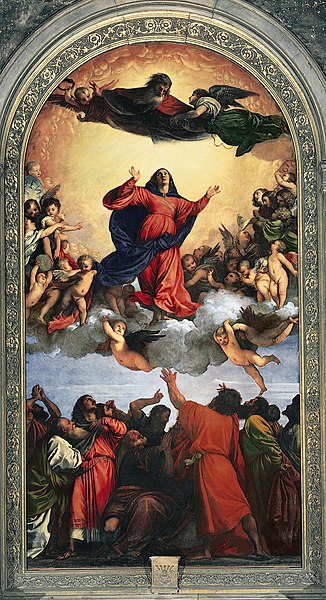Assumption of the Virgin (Titian)
The Assumption of the Virgin or Frari Assumption, popularly known as the Assunta, is a large altarpiece panel painting in oils by the Italian Renaissance artist Titian, painted in 1515–1518. It remains in the position it was designed for, on the high altar of the Basilica di Santa Maria Gloriosa dei Frari or Frari church in Venice. It is the largest altarpiece in the city, with the figures well over life-size, necessitated by the large church, with a considerable distance between the altar and the congregation.
The images above and below are not Titian's work, they are by Palma Vecchio.
It marked a new direction in Titian's style, that reflected his awareness of the developments in High Renaissance painting further south, in Florence and Rome, by artists including Raphael and Michelangelo. The agitated figures of the Apostles marked a break with the usual meditative stillness of saints in Venetian painting, in the tradition of Giovanni Bellini and others.

Assumption of the Virgin (Titian)
Assumption of the Virgin (Titian)
The full framing reredos
The painting seen through the arch in the choir-screen
An altarpiece is an work of art in painting, sculpture or relief representing a religious subject made for placing at the back of or behind the altar of a Christian church. Though most commonly used for a single work of art such as a painting or sculpture, or a set of them, the word can also be used of the whole ensemble behind an altar, otherwise known as a reredos, including what is often an elaborate frame for the central image or images. Altarpieces were one of the most important products of Christian art especially from the late Middle Ages to the era of Baroque painting.
The Ghent Altarpiece (1432) by Hubert and Jan van Eyck, with its wings open. Considered one of the masterpieces of Early Netherlandish painting, a complex polyptych panel winged altarpiece, which lost its elaborate framework in the Reformation.
Ghent Altarpiece (1432), as above, closed view with the wings folded in.
Vigoroso da Siena's altarpiece from 1291, an example of an early painted panel altarpiece, with the individual parts framed by gables and sculptured elements
Rothenburg: The Altarpiece of the Holy Blood, by Tilman Riemenschneider (1501–1505). An example of an altarpiece with a central, sculpted section and relief wings.








